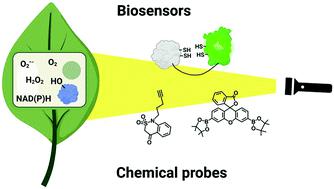当前位置:
X-MOL 学术
›
RSC Chem. Biol.
›
论文详情
Our official English website, www.x-mol.net, welcomes your feedback! (Note: you will need to create a separate account there.)
Measuring ROS and redox markers in plant cells
RSC Chemical Biology Pub Date : 2021-06-29 , DOI: 10.1039/d1cb00071c Salma Akter 1, 2 , Mohammad Shahneawz Khan 1, 2 , Edward N Smith 3 , Emily Flashman 1
RSC Chemical Biology Pub Date : 2021-06-29 , DOI: 10.1039/d1cb00071c Salma Akter 1, 2 , Mohammad Shahneawz Khan 1, 2 , Edward N Smith 3 , Emily Flashman 1
Affiliation

|
Reactive oxygen species (ROS) are produced throughout plant cells as a by-product of electron transfer processes. While highly oxidative and potentially damaging to a range of biomolecules, there exists a suite of ROS-scavenging antioxidant strategies that maintain a redox equilibrium. This balance can be disrupted in the event of cellular stress leading to increased ROS levels, which can act as a useful stress signal but, in excess, can result in cell damage and death. As crop plants become exposed to greater degrees of multiple stresses due to climate change, efforts are ongoing to engineer plants with greater stress tolerance. It is therefore important to understand the pathways underpinning ROS-mediated signalling and damage, both through measuring ROS themselves and other indicators of redox imbalance. The highly reactive and transient nature of ROS makes this challenging to achieve, particularly in a way that is specific to individual ROS species. In this review, we describe the range of chemical and biological tools and techniques currently available for ROS and redox marker measurement in plant cells and tissues. We discuss the limitations inherent in current methodology and opportunities for advancement.
中文翻译:

测量植物细胞中的 ROS 和氧化还原标记
活性氧 (ROS) 在整个植物细胞中产生,作为电子转移过程的副产品。虽然具有高度氧化性并且可能对一系列生物分子造成损害,但存在一套清除活性氧的抗氧化策略来维持氧化还原平衡。如果细胞应激导致 ROS 水平升高,这种平衡可能会被破坏,ROS 水平可以作为有用的应激信号,但过量会导致细胞损伤和死亡。由于气候变化,农作物受到更大程度的多重胁迫,人们正在努力设计具有更高胁迫耐受性的植物。因此,通过测量 ROS 本身和其他氧化还原失衡指标来了解 ROS 介导的信号传导和损伤的途径非常重要。ROS 的高反应性和瞬态性使得实现这一目标具有挑战性,特别是针对单个 ROS 物种特有的方式。在这篇综述中,我们描述了目前可用于植物细胞和组织中 ROS 和氧化还原标记物测量的化学和生物工具和技术的范围。我们讨论当前方法固有的局限性和进步的机会。
更新日期:2021-07-06
中文翻译:

测量植物细胞中的 ROS 和氧化还原标记
活性氧 (ROS) 在整个植物细胞中产生,作为电子转移过程的副产品。虽然具有高度氧化性并且可能对一系列生物分子造成损害,但存在一套清除活性氧的抗氧化策略来维持氧化还原平衡。如果细胞应激导致 ROS 水平升高,这种平衡可能会被破坏,ROS 水平可以作为有用的应激信号,但过量会导致细胞损伤和死亡。由于气候变化,农作物受到更大程度的多重胁迫,人们正在努力设计具有更高胁迫耐受性的植物。因此,通过测量 ROS 本身和其他氧化还原失衡指标来了解 ROS 介导的信号传导和损伤的途径非常重要。ROS 的高反应性和瞬态性使得实现这一目标具有挑战性,特别是针对单个 ROS 物种特有的方式。在这篇综述中,我们描述了目前可用于植物细胞和组织中 ROS 和氧化还原标记物测量的化学和生物工具和技术的范围。我们讨论当前方法固有的局限性和进步的机会。

























 京公网安备 11010802027423号
京公网安备 11010802027423号